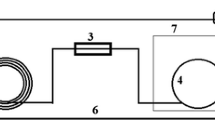Summary
The velocity of hydrolysis of some acetanilide derivatives by guinea pig liver microsomes was found to be proportional to the microsome content of the suspension.
Several extractions of the homogenate prepared from the livers of various species were needed for extracting most of the activity located in the soluble and the microsomal fraction.
Acetanilide, p-acetaminophenol, phenacetin, and a ring-substituted phenacetin derivative (compound IX) were used as substrates in measuring the hydrolytic activity in the microsomal and soluble fraction from liver. The ratio between these activities was found to vary widely with the substrate and the species (rabbit, guinea pig, dog, and cat) used. The soluble fractions of all species hydrolyzed acetanilide more rapidly than the microsomes, and the microsomes were more active than the soluble fractions in hydrolyzing the ring-substituted phenacetin derivative.
In a study of the hydrolysis of acetanilide and 12 derivatives by the microsomes prepared from the livers of rabbits, dogs, and guinea pigs the replacement of the N-acetyl residue in phenacetin by α-dimethylamino-β-hydroxybutyric acid was found to decrease the rate of hydrolysis. Substitution of an acetyl, propionyl, or butyryl residue in m-position to the amino group of phenacetin increased the rate of hydrolysis.
N-methyl phenacetin was hydrolyzed more slowly than phenacetin by the soluble fractions prepared from guinea pig's, rabbit's dog's and cat's liver and by the microsomes except those from guinea pigs. The substitution of an N-methyl group in α-dimethylamino-β-hydroxybutyric acid phenetidide produced a compound which was found not to be hydrolyzed by microsomes or soluble fraction from the livers of the 4 species—or so slowly that it could not be detected in our experiments.
Similar content being viewed by others
References
Bernhammer, E., and K. Krisch: Deacetylation of phenacetin by liver esterase. Biochem. Pharmacol. 14, 863 (1965).
Booth, J., and E. Boyland: The biochemistry of aromatic amines. 3. Enzymic hydroxylation by rat-liver microsomes. Biochem. J. 66, 73 (1957).
Bray, H. G., S. P. James, I. M. Raffan, B. E. Ryman, and W. V. Thorpe: The fate of certain organic acids and amides in the rabbit. 7. An amidase of rabbit liver. Biochem. J. 44, 618 (1949).
— W. V. Thorpe, and M. R. Wasdell: Deacetylation of acetamido compounds by tissue extracts. Biochem. J. 47, 483 (1950).
Brodle, B. B., and J. Axelrod: The estimation of acetanilide and its metabolic products, aniline, N-acetyl-p-aminophenol, and p-aminophenol (free and total conjugated) in biological fluids and tissues. J. Pharmacol. exp. Ther. 94, 22 (1948).
Ehrhart, G., E. Lindner u. A. Häussler: Eine neue Gruppe analgetisch wirk-samer Abkömmlinge des Phenetidins. Arzneimittel-Forsch. 15, 727 (1965).
Gornall, A. G., C. J. Bardawill, and M. M. David: Determination of serum proteins by means of the biuret reaction. J. biol. Chem. 177, 751 (1948).
Hinsberg, O.: Einige Derivate des p-Aminophenols. Justus Liebigs Ann. Chem. 305, 280 (1899).
Hollunger, G.: Solubilization and purification of an amidehydrolysing microsomal enzyme. Acta pharmacol. (Kbh.) 17, 374 (1960).
— Some characteristics of an amide-hydrolysing microsomal enzyme before and after its solubilization. Acta pharmacol. (Kbh.) 17, 384 (1960).
Hustedt, G., u. M. Kiese: Umsetzungen von Acetanilid und Acetylphenylhydroxylamin im Organismus. Naunyn-Schmiedebergs Arch. exp. Path. Pharmak. 236, 435 (1959).
Irving, C. C.: Deacetylation of N-hydroxy-2-acetylaminofluorene by guinea pig liver microsomes. Fed. Proc. 24, 152 (1965).
Jagow, R. von, H. Kampffmeyer, and M. Kiese: The preparation of microsomes. Naunyn-Schmiedebergs Arch. exp. Path. Pharmak. 251, 73 (1965).
Kadatz, R., u. H. Ueberberg: Pharmakologische und toxikologische Untersuchung eines neuen Analgeticum-Antiphlogisticums, 2-(2-Methoxy-äthoxy)-5-acetamino-acetophenon. Arzneimittel-Forsch. 15, 520 (1965).
Kiese, M., u. K. H. Plattig: Hämiglobinbildung durch Benzoylphenylhydroxylamin. Naunyn-Schmiedebergs Arch. exp. Path. Pharmak. 235, 373 (1959).
—, and E. Rauscher: The failure of some aromatic amines to produce hemiglobin in vivo in spite of microsomal N-hydroxylation. Naunyn-Schmiedebergs Arch. exp. Path. Pharmak. 251, 201 (1965).
--, and R. M. von Wolff: Unpublished experiments. Tübingen 1958.
Kohl, M. F. F., and L. M. Flynn: Deacylation of N4-n-acylsulfanilamides and N4-n-acylsulfanilylhydroxamides in vitro. Proc. Soc. exp. Biol. (N. Y.) 44, 455 (1940).
Krebs, H. A., W. O. Sykes, and W. C. Bartley: Acetylation and deacetylation of the p-amino group of sulfonamide drugs in animal tissues. Biochem. J. 41, 622 (1947).
Krisch, K.: Isolierung einer Esterase aus Schweinelebermikrosomen. Biochem. Z. 337, 531 (1963).
— Eigenschaften und Substratspezifität einer Esterase aus Schweinelebermikrosomen. Biochem. Z. 337, 546 (1963).
Kurz, H., u. G. Renner: Eine optische Methode zur Bestimmung von sekundären Aminen. Z. analyt. Chem. 186, 39 (1962).
Michel, H. O., F. Bernheim, and M. L. C. Bernheim: The hydrolysis of acetanilide by various tissues. J. Pharmacol. exp. Ther. 61, 321 (1937).
Minkowski, E.: Über das Verhalten einiger aromatischer Essigsäure- und Glykokollderivate tierischen Fermenten gegenüber. Diss., München 1909.
Nagasawa, H. T., and H. R. Gutmann: A note on the deacylation of the carcinogen 2-acetamidofluorene and related compounds by rat liver and intestine. Biochim. biophys. Acta (Amst.) 25, 186 (1957).
Peters, J. H., and H. R. Gutmann: The acetylation of 2-aminofluorene and the deacetylation and concurrent reacetylation of 2-acetylaminofluorene by rat liver slices. J. biol. Chem. 216, 713 (1955).
Seal, U. S., and H. R. Gutmann: The metabolism of the carcinogen N-(2-fluorenyl) acetamide by liver cell fractions. J. biol. Chem. 234, 648 (1959).
Weisburger, J. H.: The enzymic deacetylation of the carcinogen 2-acetylamino-fluorene and related compounds. Biochim. biophys. Acta (Amst.) 16, 382 (1955).
Author information
Authors and Affiliations
Rights and permissions
About this article
Cite this article
Kiese, M., Renner, G. The hydrolysis of acetanilide and some of its derivatives by enzymes in the microsomal and soluble fraction prepared from livers of various species. Naunyn - Schmiedebergs Arch 252, 480–500 (1966). https://doi.org/10.1007/BF00258646
Received:
Issue Date:
DOI: https://doi.org/10.1007/BF00258646




